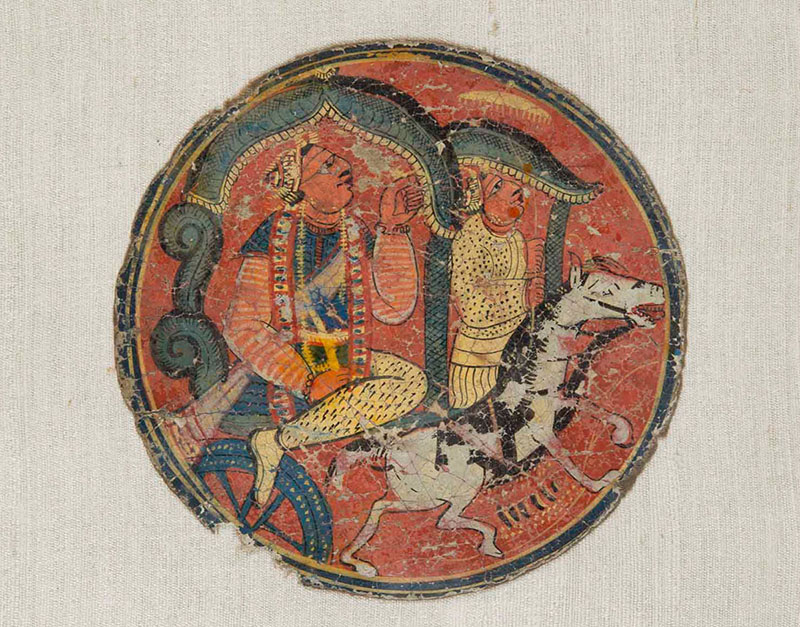ARTICLE
Ganjifa
The jewelled crown of the taj suit is likely modelled after the Sassanian-style crown used in Persia, or the Timurid headdress from Central Asia, which is in turn a more elaborate version of the Mongolian hat. The shamsher suit is relatively uniform, usually showing a similar curved sword in every pack, with the grip sometimes being covered by a knuckle-guard. The figures of the shamsher court cards are often shown in battle armour, perhaps to complement the weapon. The motif on cards in the chang suit is a small harp of Persian or Chinese origin. The court cards for the chang suit show only women playing the harp. In the case of the shah card in this suit, the woman sits on a throne among companions, and in the wazir card she rides a camel. The instrument itself never gained popularity in India and has historically caused the most confusion among ganjifa artists, leading to this suit being drawn in a variety of imaginative ways. The two money suits, tanka and ashrafi, are represented by silver and gold coins respectively. Additionally, the ashrafi suit’s court cards are shown as lions, tigers or the sun, possibly due to the association of these symbols with the imperial courts of West and Central Asia at the time. The qimash suit, intended to represent comfort, depicts stylised bolsters commonly used in North India. The barat suit has the simplest motif, usually a rectangle, or occasionally a circle, with a green outline.
While packs used by the Mughal court were made with precious materials such as ivory and tortoiseshell, the cards used by the general public were made with starched cloth, papier mache or palm leaf, sometimes with a lacquered face. Ganjifa cards were historically elaborately painted, although factors such as demand, prevailing tastes and scale of production did impact the quality of card design at different points in time. Unlike the rectangular West Asian cards, Indian ganjifa cards are typically circular in shape. The court cards are usually the most meticulously designed, reflecting their typically high status in the gameplay. These cards, especially those from packs used by royalty and nobility, were often treated as miniature paintings in their own right, with a king or minister painted atop a horse against a background of hills or forest, and the symbol of the suit deftly worked into the composition.
Several variations on the Mughal game have been designed over time, some of which include: a twelve-suited version invented by Akbar known as Akbar’s ganjifa; ganjapa, which is played in Odisha today and closely follows Mughal ganjifa; the ten-suited dashavatara ganjifa, made according to the ten incarnations of Vishnu; Mysore chad ganjifa; naqsh ganjifa; sawantwadi ganjifa from Maharashtra; and Ramayana ganjapa, also from Odisha. From the early twentieth century onwards, Western playing cards became more popular in India than ganjifa, due to their simpler four-suit system, easily mass-produced cards and the wide variety of games they served.
The game is rarely played today, with painters (or chitrakars) in Odisha, Maharashtra and Mysore occasionally producing novelty packs intended as display pieces. In recent years, artists and institutions have taken some steps to revive ganjifa, a notable example of which is Splendours of Ganjifa Art, a book on the game’s history released by the Chitrakala Parishath, Bengaluru in 2019.
Bibliography
Govind, Ranjani. “Game with Ganjifa Cards.” The Hindu, November 13, 2019. https://www.thehindu.com/society/history-and-culture/game-with-ganjifa-cards/article29962309.ece.
Living Traditions: Tribal and Folk Paintings of India. New Delhi: Centre for Cultural Resources and Training, Ministry of Culture, Government of India, 2017.
von Leyden, Rudolf. Ganjifa: The Playing Cards of India. London: Victoria and Albert Museum, 1982.








